Effective Electrical Properties and Fault Diagnosis of Insulating Oil Using the 2D Cell Method and NSGA-II Genetic Algorithm
Abstract
:1. Introduction
2. Theoretical Background
2.1. Test Device Container
2.2. Distributed Parameter Model
2.3. Lumped Parameter Model
3. Non-Destructive Insulation Tests
3.1. Electrical Connection Diagram
3.2. Schering Bridge
3.3. High-Voltage Tests
3.3.1. Laboratory Description
3.3.2. Diagram of the Connections for the Electrical Test Equipment
3.3.3. Temperature Measurement and Control Procedure
3.3.4. Test Results
- Rp = Parallel resistance of the equivalent circuit of lumped parameters.
- Cp = Parallel capacity of the equivalent circuit of lumped parameters.
- = Electric current passing through the reference capacitor CN of 100 pF.
- = Electric current passing through the capacitor Cp.
- tan δ = Ratio between the electric current that passes through the resistance Rp and the current , as defined in Equation (9).
- QF = Quality factor. Ratio between the energy stored in the electric field of the real capacitor Cp divided by the energy dissipated by the resistance Rp in a period of time at the operating frequency.
4. Fit of the Effective Parameters Using the CM and NSGA-II
4.1. Methodology
- Step 1. An initial random population of size N is generated, respecting the ranges of the variables. In this particular problem, the physical properties to be determined () are equivalent to a chromosome. In addition, the values of the objective functions g1 and g2 are evaluated, which are the errors with respect to a reference of the experimental values Cp and Rp for that combination of variables.
- Step 2. The initial population is classified based on the values of the objective functions to generate several non-dominated fronts. Each member of each front is assigned a fitness value, called a rank.
- Step 3. The crowding distance of each member in each front is calculated. The fronts are ordered according to their objective values.
- Step 4. According to the range and crowding distance, the main population is ordered by selecting the nest individuals through a binary tournament competition.
- Step 5. From those selected in the previous step, the original population is crossed and mutated to generate an offspring population.
- Step 6. The initial population of parents and offspring obtained from Step 5 is combined to generate a population size of 2N. From this last selection, elitism is performed to select the best population of size N, according to the value of the objective functions.
- Step 7. The stopping criterion of the iteration in progress is checked, which consists of verifying if the maximum number of generations has been attained. If this condition is not reached, steps 2 to 7 are repeated.
4.2. Results and Discussion
5. Conclusions
Author Contributions
Funding
Institutional Review Board Statement
Informed Consent Statement
Data Availability Statement
Acknowledgments
Conflicts of Interest
Nomenclature
| Symbol | Name | Unit |
| mobility constant | S/m | |
| ADC | analogical digital converter | - |
| parallel capacity | F | |
| reference capacitor | F | |
| incidence matrix face–volume in dual mesh | - | |
| DSP | digital signal processing (Figure 7a) | - |
| & | complex electric field and its conjugate | V/m |
| activation energy | eV | |
| frequency | Hz | |
| G, Gt | incidence matrix edges–nodes of primal mesh and transpose mat. | - |
| conductance | S | |
| objective functions | - | |
| incidence vector of relative cohomology between oil volume and electrode surface | - | |
| complex capacitive current | A | |
| complex reference capacitor intensity | A | |
| complex resistive current | A | |
| complex total current | A | |
| j | imaginary unit | - |
| volumetric density current | A/m2 | |
| Boltzmann constant | J/K | |
| electrical permittivity constitutive matrix | F | |
| Mσ | electric conductivity constitutive matrix | S |
| average total losses over time–rms value | W | |
| QF | quality factor | - |
| parallel resistance | Ω | |
| highly accurate shunts and | Ω | |
| temperature | °C, K | |
| time | s | |
| tangent of delta | - | |
| conduction | - | |
| dielectric hysteresis | - | |
| polarization | - | |
| ionization | - | |
| complex test voltage | V | |
| complex voltage in shunts and | V | |
| volume | m3 | |
| time-averaged electrical energy–rms value | J | |
| complex admittance | S | |
| ε | electrical permittivity of the medium | F/m |
| εr | relative electrical permittivity | - |
| ε0 | electrical permittivity in vacuum | F/m |
| resistivity | Ω·m | |
| σ | electric conductivity | S/m |
| φ | scalar electric potential | V |
| phase difference between voltages and | rad | |
| angle of | rad | |
| angle of | rad | |
| angular frequency | rad/s |
References
- Available online: https://www.iea.org/world (accessed on 5 January 2023).
- Wang, X.; Tang, C.; Huang, B.; Hao, J.; Chen, G. Review of Research Progress on the Electrical Properties and Modification of Mineral Insulating Oils Used in Power Transformers. Energies 2018, 11, 487. [Google Scholar] [CrossRef]
- Naderian, A.; Cress, S.; Piercy, R.; Wang, F.; Service, J. An Approach to Determine the Health Index of Power Transformers. In Proceedings of the Conference Record of the 2008 IEEE International Symposium on Electrical Insulation, Vancouver, BC, Canada, 9–12 June 2008; pp. 192–196. [Google Scholar] [CrossRef]
- Mariprasath, T.; Kirubakaran, V.; Madichetty, S.; Amaresh, K. An experimental study on spectroscopic analysis of alternating liquid dielectrics for transformer. Electr. Eng. 2021, 103, 921–929. [Google Scholar] [CrossRef]
- Taslak, E.; Arikan, O.; Kumru, C.F.; Kalenderli, O. Analyses of the insulating characteristics of mineral oil at operating conditions. Electr. Eng. 2018, 100, 321–331. [Google Scholar] [CrossRef]
- Rozga, P.; Beroual, A. High Voltage Insulating Materials—Current State and Prospects. Energies 2021, 14, 3799. [Google Scholar] [CrossRef]
- Liao, R.; Hao, J.; Chen, G.; Ma, Z.; Yang, L. A comparative study of physicochemical, dielectric and thermal properties of pressboard insulation impregnated with natural ester and mineral oil. IEEE Trans. Dielectr. Electr. Insul. 2011, 18, 1626–1637. [Google Scholar] [CrossRef]
- Sudha, L.K.; Sukumar, R.; Uma, R.K. Evaluation of Activation Energy (Ea) Profiles of Nanostructured Alumina Polycarbonate Composite Insulation Materials. Int. J. Mater. Mech. Manuf. 2014, 2, 96–100. [Google Scholar] [CrossRef]
- Teymouri, A.; Vahidi, B. Estimation of power transformer remaining life from activation energy and pre-exponential factor in the Arrhenius equation. Cellulose 2019, 26, 9709–9720. [Google Scholar] [CrossRef]
- Sangineni, R.; Nayak, S.K.; Becerra, M. A Non-Intrusive and Non-Destructive Technique for Condition Assessment of Transformer Liquid Insulation. IEEE Trans. Dielectr. Electr. Insul. 2022, 29, 693–700. [Google Scholar] [CrossRef]
- Yang, Z.; Chen, W.; Yang, D.; Song, R. A Novel Recognition Method of Aging Stage of Transformer Oil-Paper Insulation Using Raman Spectroscopic Recurrence Plots. IEEE Trans. Dielectr. Electr. Insul. 2022, 29, 1152–1159. [Google Scholar] [CrossRef]
- ASTM D924-15. Standard Test Method for Dissipation Factor (or Power Factor) and Relative Permittivity (Dielectric Constant) of Electrical Insulating Liquids. 2015. Available online: https://www.astm.org/d0924-15.html (accessed on 5 January 2023).
- IEC 60247. Insulating Liquids–Measurement of Relative Permittivity, Dielectric Dissipation Factor (tan δ) and dc Resistivity. 2004. Available online: https://webstore.iec.ch/publication/1150 (accessed on 5 January 2023).
- Katoch, S.; Chauhan, S.S.; Kumar, V. A review on genetic algorithm: Past, present, and future. Multimed. Tools Appl. 2021, 80, 8091–8126. [Google Scholar] [CrossRef]
- Fonseca, C.M.; Fleming, P.J. Genetic Algorithms for Multiobjective Optimization: Formulation, Discussion and Generalization. In ICCI ’93: Proceedings of the Fifth International Conference on Computing and Information; Morgan Kaufmann Publishers: San Mateo, CA, USA, 1993. [Google Scholar]
- Deb, K.; Pratap, A.; Agarwal, S.; Meyarivan, T. A fast and elitist multiobjective genetic algorithm: NSGA-II. IEEE Trans. Evol. Comput. 2002, 6, 182–197. [Google Scholar] [CrossRef]
- Li, J.; Zhang, Q.; Wang, K.; Wang, J.; Zhou, T.; Zhang, Y. Optimal dissolved gas ratios selected by genetic algorithm for power transformer fault diagnosis based on support vector machine. IEEE Trans. Dielectr. Electr. Insul. 2016, 23, 1198–1206. [Google Scholar] [CrossRef]
- Wu, S.; Zhang, H.; Wang, Y.; Luo, Y.; He, J.; Yu, X.; Zhang, Y.; Liu, J.; Shuang, F. Concentration Prediction of Polymer Insulation Aging Indicator-Alcohols in Oil Based on Genetic Algorithm-Optimized Support Vector Machines. Polymers 2022, 14, 1449. [Google Scholar] [CrossRef]
- Fresno, J.; Ardila-Rey, J.; Martinez-Tarifa, J.; Robles, G. Partial discharges and noise separation using spectral power ratios and genetic algorithms. IEEE Trans. Dielectr. Electr. Insul. 2017, 24, 31–38. [Google Scholar] [CrossRef]
- Orosz, T.; Pánek, D.; Karban, P. FEM Based Preliminary Design Optimization in Case of Large Power Transformers. Appl. Sci. 2020, 10, 1361. [Google Scholar] [CrossRef]
- Monzón-Verona, J.M.; Garcia-Alonso, S.; Sosa, J.; Montiel-Nelson, J.A. Multi-objective genetic algorithms applied to low power pressure microsensor design. Eng. Comput. 2013, 30, 1128–1146. [Google Scholar] [CrossRef]
- Tonti, E. Why starting from differential equations for computational physics? J. Comput. Phys. 2014, 257, 1260–1290. [Google Scholar] [CrossRef]
- Tonti, E. The Mathematical Structure of Classical and Relativistic Physics; Birkhäuser: New York, NY, USA, 2013; ISBN /978/1/4614/7421/0. [Google Scholar] [CrossRef]
- Bettini, P.; Specogna, R.; Trevisan, F. Electroquasistatic Analysis of the Gas Insulated Line for the ITER Neutral Beam Injector. IEEE Trans. Magn. 2009, 45, 996–999. [Google Scholar] [CrossRef]
- Monzón-Verona, J.M.; González-Domínguez, P.I.; García-Alonso, S.; Reboso, J.V. Characterization of Dielectric Oil with a Low-Cost CMOS Imaging Sensor and a New Electric Permittivity Matrix Using the 3D Cell Method. Sensors 2021, 21, 7380. [Google Scholar] [CrossRef]
- Hipotronics 6835 Test Cell for Liquid Insulants. Available online: https://res.cloudinary.com/iwh/image/upload/q_auto,g_center/assets/1/26/Hipotronics_6835_Data_Sheet.pdf (accessed on 5 January 2023).
- Sha, Y.; Zhou, Y.; Nie, D.; Wu, Z.; Deng, J. A study on electric conduction of transformer oil. IEEE Trans. Dielectr. Electr. Insul. 2014, 21, 1061–1069. [Google Scholar] [CrossRef]
- Wang, Q.; Bai, B.; Chen, D.; Fu, T.; Ma, Q. Study of Insulation Material Properties Subjected to Nonlinear AC–DC Composite Electric Field for Converter Transformer. IEEE Trans. Magn. 2019, 55, 1–4. [Google Scholar] [CrossRef]
- Melcher, J.R.; Woodson, H.H. Electromechanical dynamics. In Dynamics; John Wiley & Sons, Inc.: Hoboken, NJ, USA, 1968; Reprint Krieger Publishing Company: Malabar, FL, USA, 1985; Volume 2, ISBN 9780898748475. [Google Scholar]
- Geuzaine, C.; Remacle, J.-F. A three-dimensional finite element mesh generator with built-in pre-and post-processing facilities. Int. J. Numer. Methods Eng. 2009, 79, 1309–1331. [Google Scholar] [CrossRef]
- Pets. Portable, Extensible Toolkit for Scientific Computation. Available online: http://www.mcs.anl.gov/petsc (accessed on 5 January 2023).
- Okabe, S.; Hayakawa, N.; Murase, H.; Hama, H.; Okubo, H. Common insulating properties in insulating materials. IEEE Trans. Dielectr. Electr. Insul. 2006, 13, 327–335. [Google Scholar] [CrossRef]
- Liao, R.; Feng, D.; Hao, J.; Yang, L.; Li, J. Thermal and Electrical Properties of a Novel 3-Element Mixed Insulation Oil for Power Transformers. IEEE Trans. Dielectr. Electr. Insul. 2019, 26, 610–617. [Google Scholar] [CrossRef]
- Sangineni, R.; Baruah, N.; Nayak, S.K. Study of the Dielectric Frequency Response of Mineral Oil on addition of Carboxylic Acids. In Proceedings of the IEEE Conference on Electrical Insulation and Dielectric Phenomena (CEIDP), Denver, CO, USA, 30 October–2 November 2022; pp. 143–146. [Google Scholar] [CrossRef]
- Kuffel, E.; Kuffel, J. High Voltage Engineering: Fundamentals, 2nd ed.; Elsevier: Amsterdam, The Netherlands, 2000; ISBN 9780750636346. [Google Scholar]
- DS18B20 Waterproof Temperature Sensors. Available online: https://www.quick-teck.co.uk/ (accessed on 5 January 2023).
- Thermographic Camera FLIR E54. Available online: https://www.flir.es/products/e54/ (accessed on 5 January 2023).
- Thermal Sensitivity. Available online: https://www.termagraf.com/sensibilidad-termica-en-termografia/ (accessed on 5 January 2023).
- Boliang, Z.; Yiwei, L.; Yong, Y.; Ming, Z.; Li, J.; Shusheng, W. Multi-OBJECTIVE optimization Design of the Large Scale. Available online: https://ietresearch.onlinelibrary.wiley.com/doi/full/10.1049/elp2.12188 (accessed on 5 January 2023).
- Deb, K.; Mohan, M.; Mishra, S. A fast multiobjective evolutionary algorithm for finding wellspread pareto-optimal solutions. In KanGAL Report No. 2003002; Indian Institute of Technology Kanpur: Kanpur, India, 2002. [Google Scholar]
- Gaffney, J.; Pearce, C.; Green, D. Binary versus real coding for genetic algorithms: A false dichotomy? Anziam J. 2009, 51, C347–C359. [Google Scholar] [CrossRef]
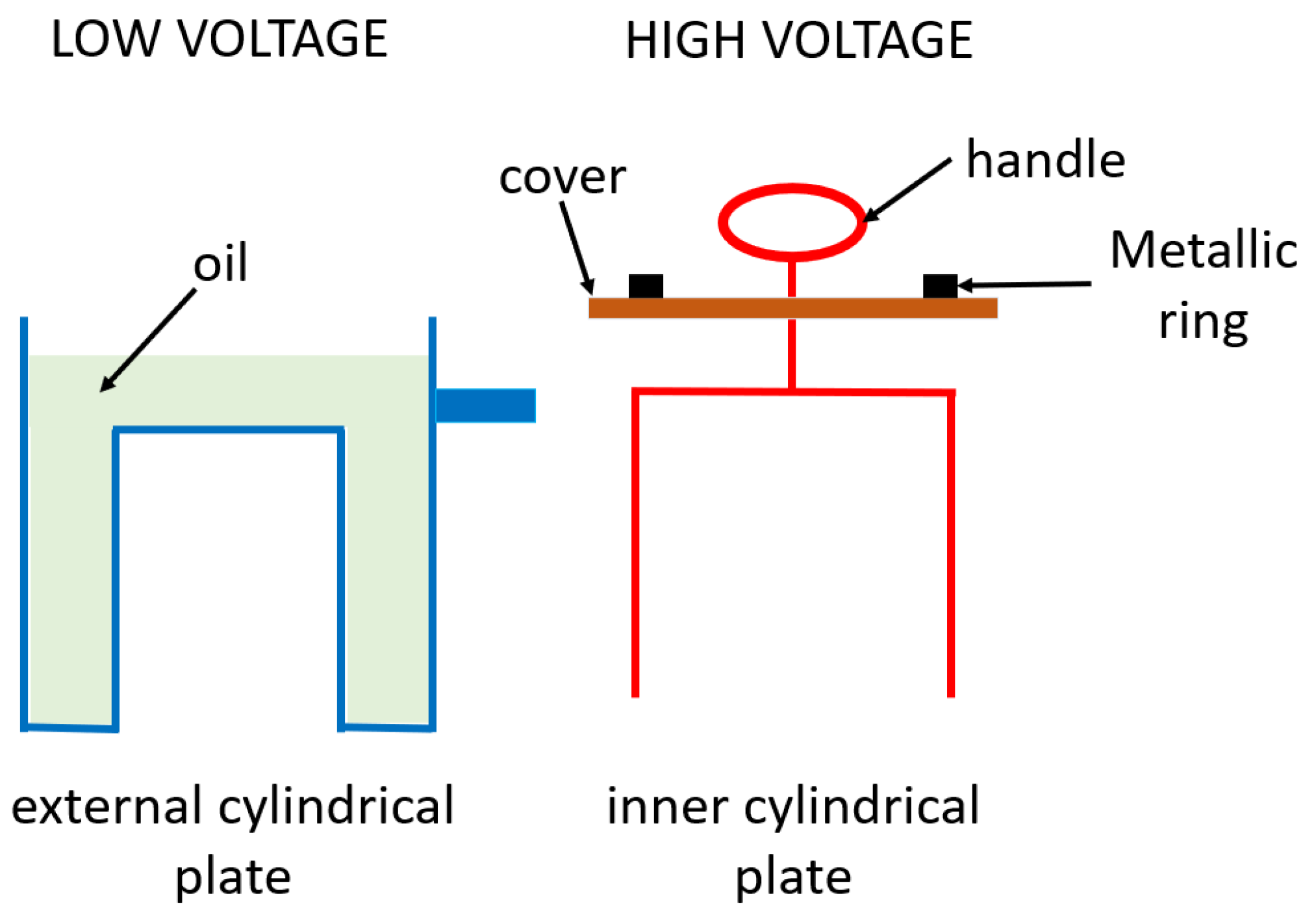
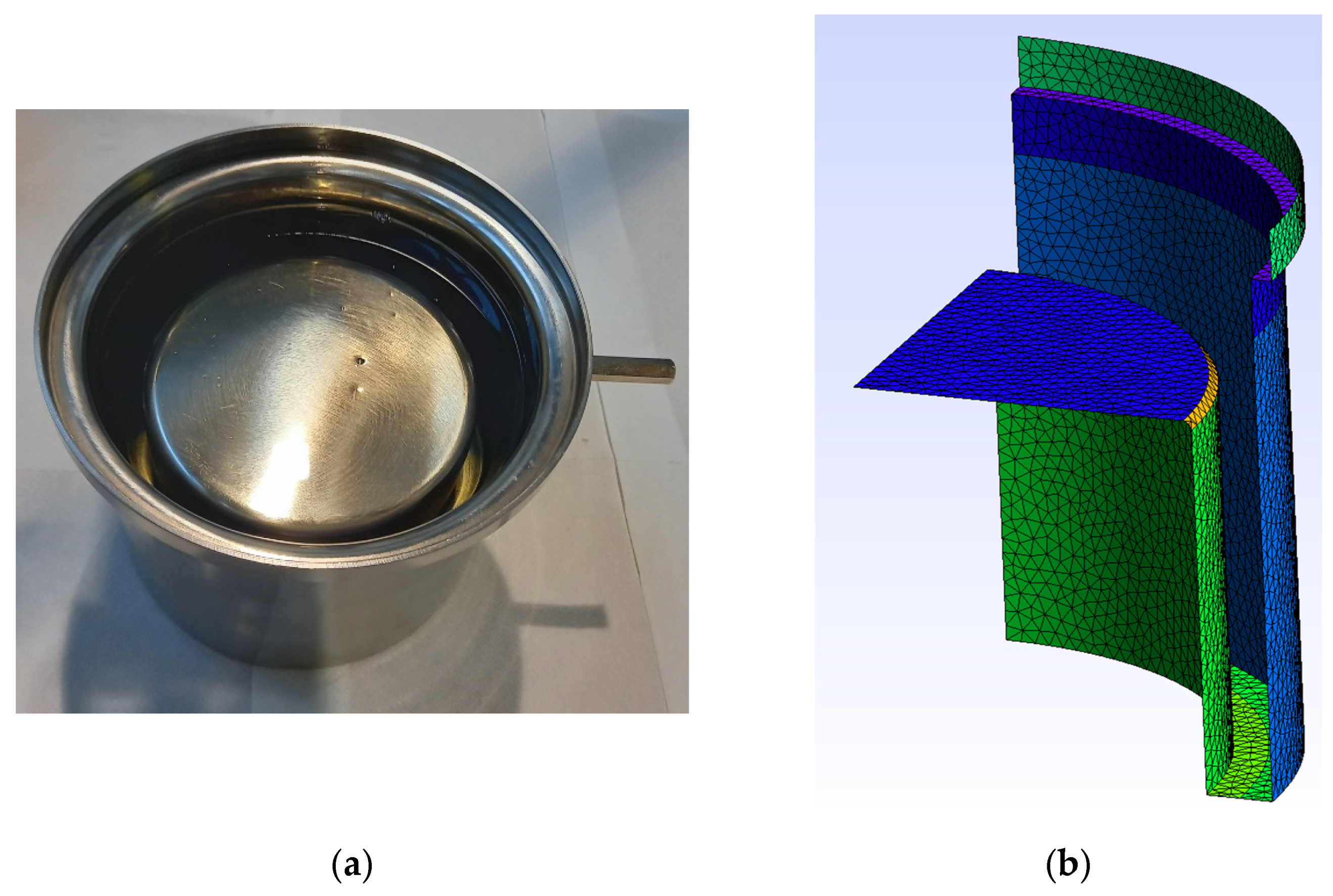
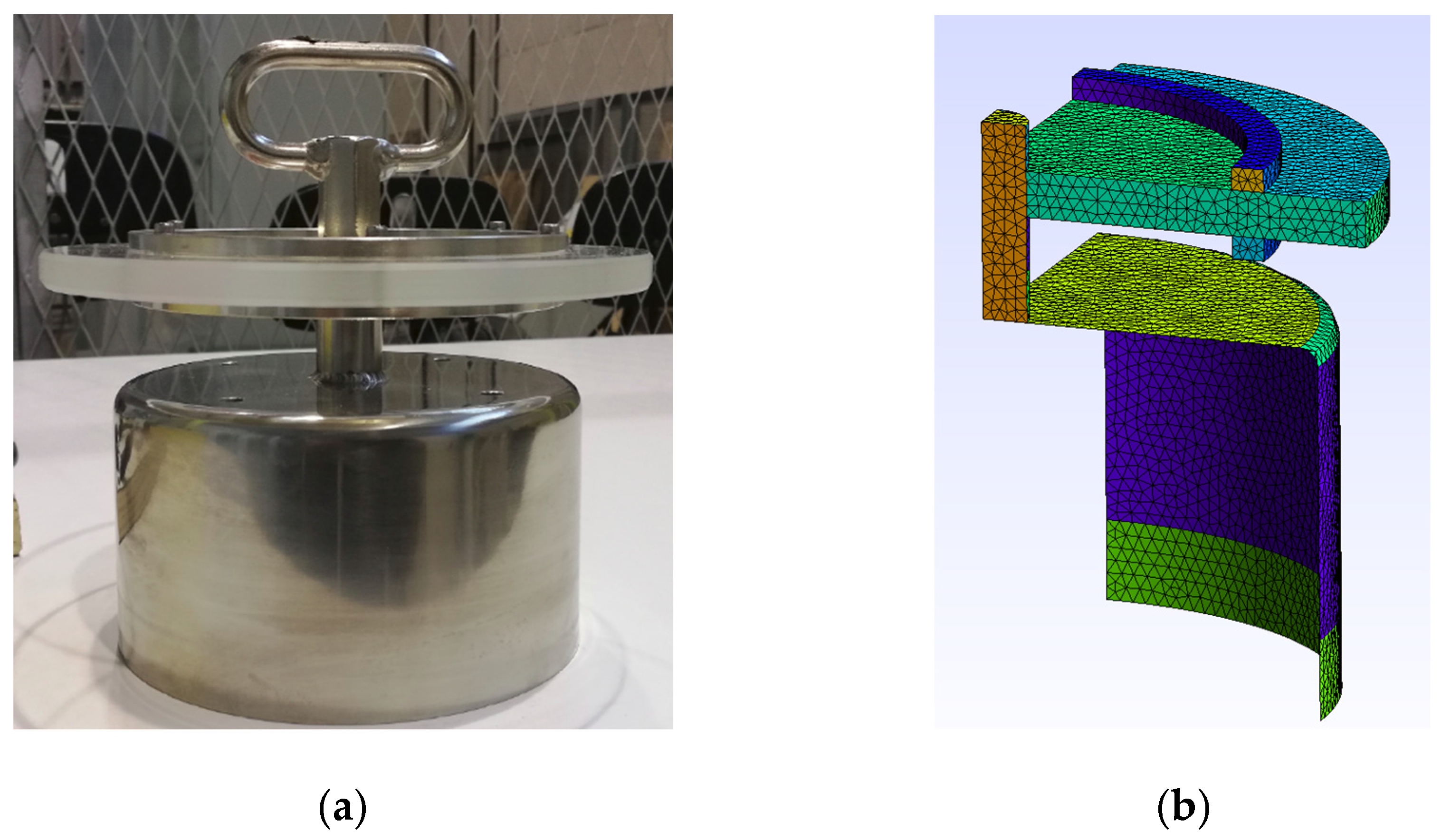

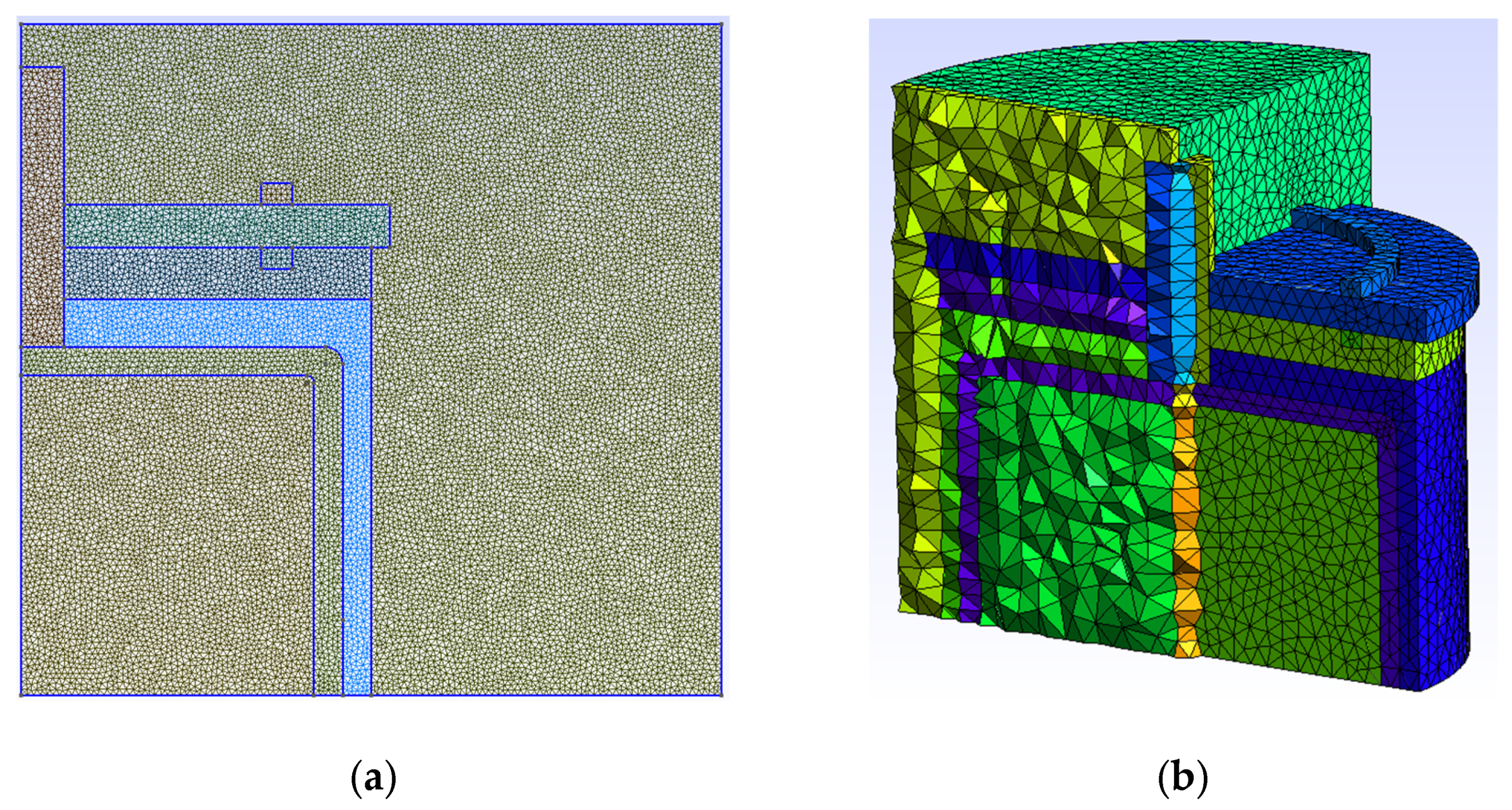
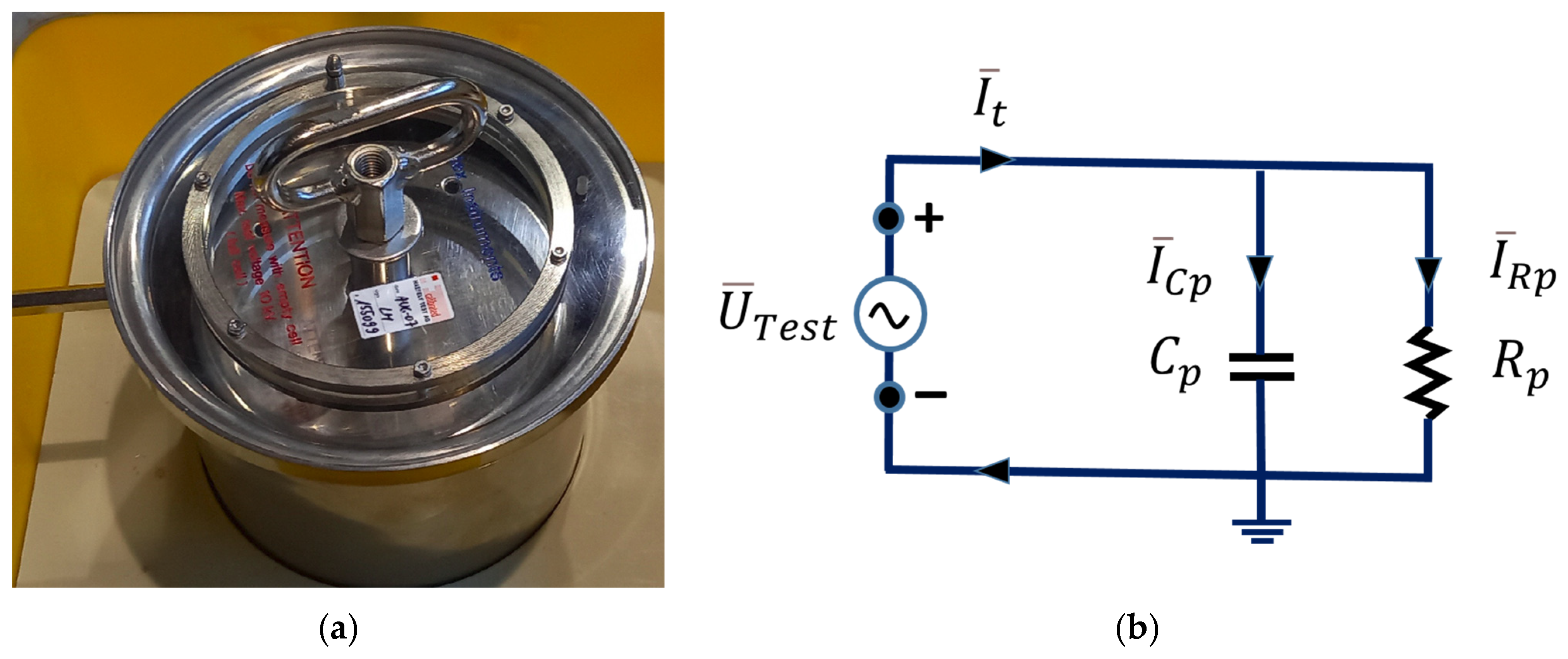
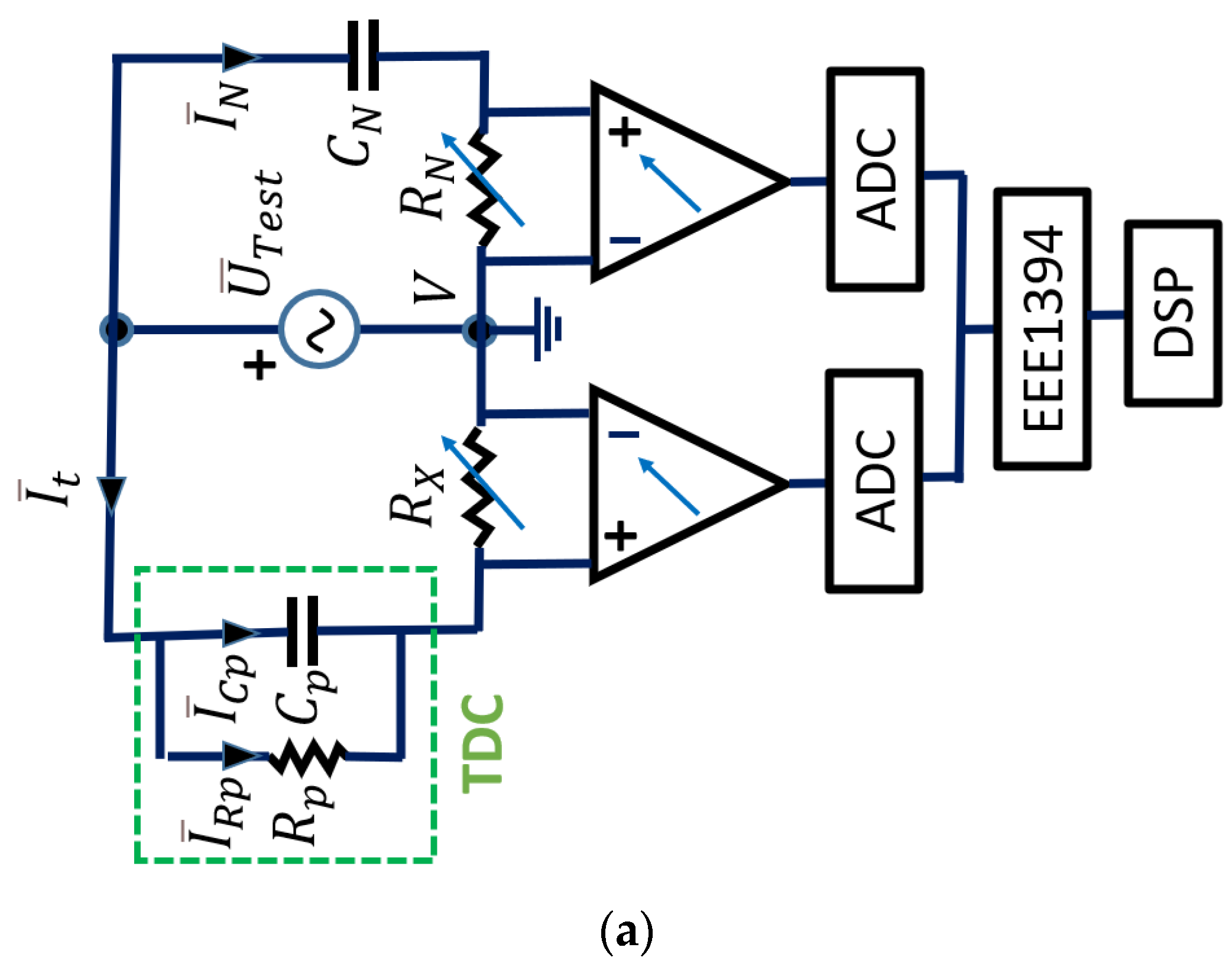
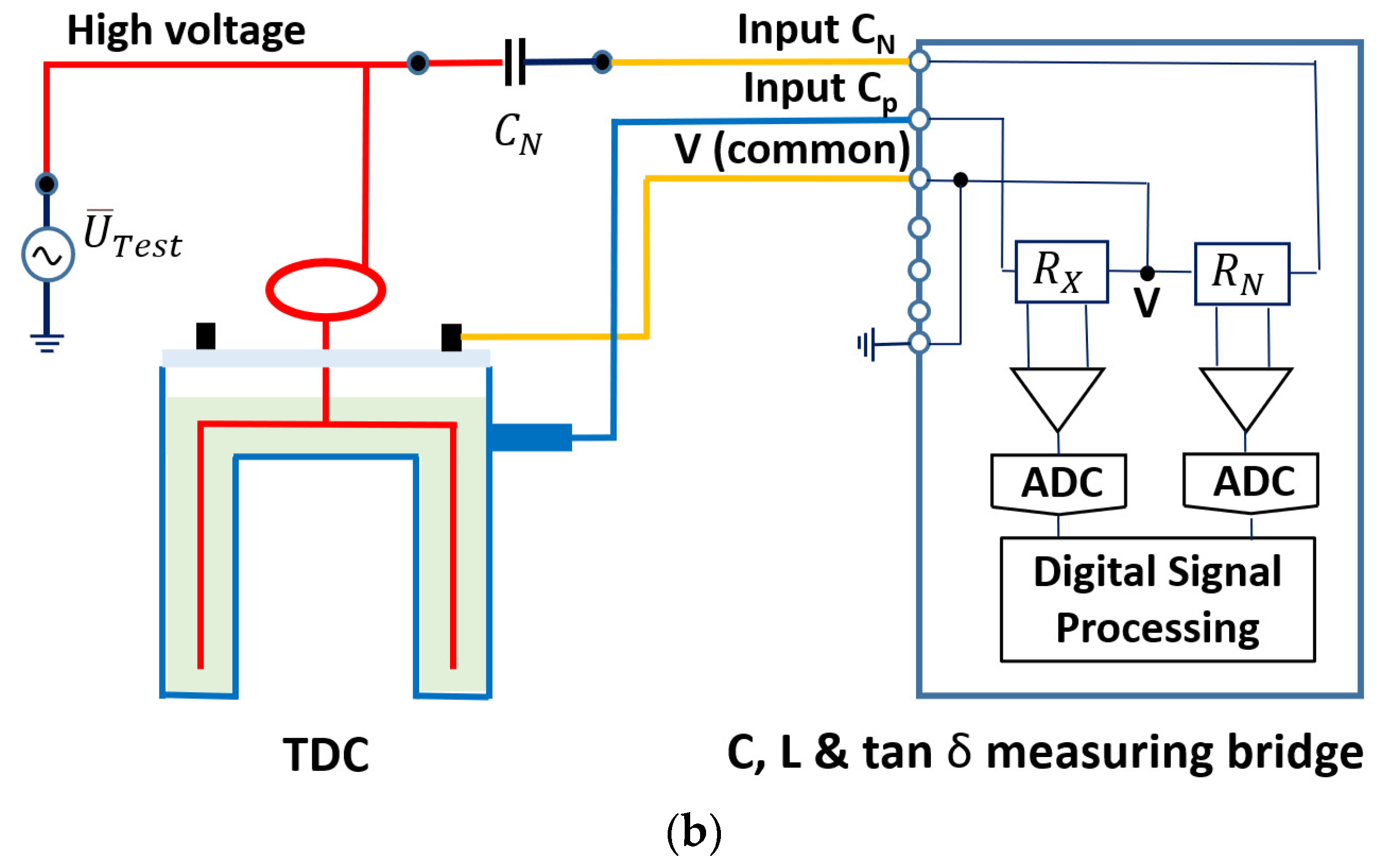
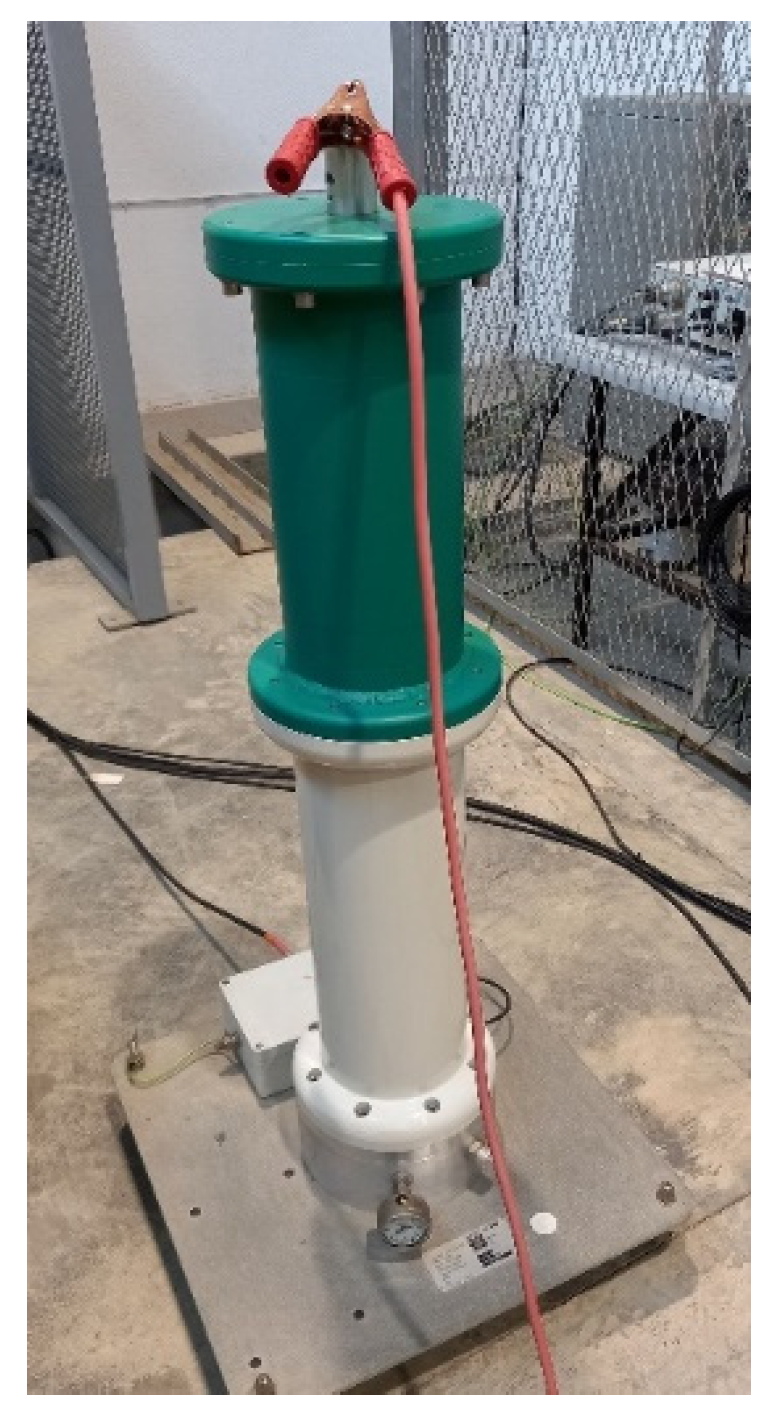


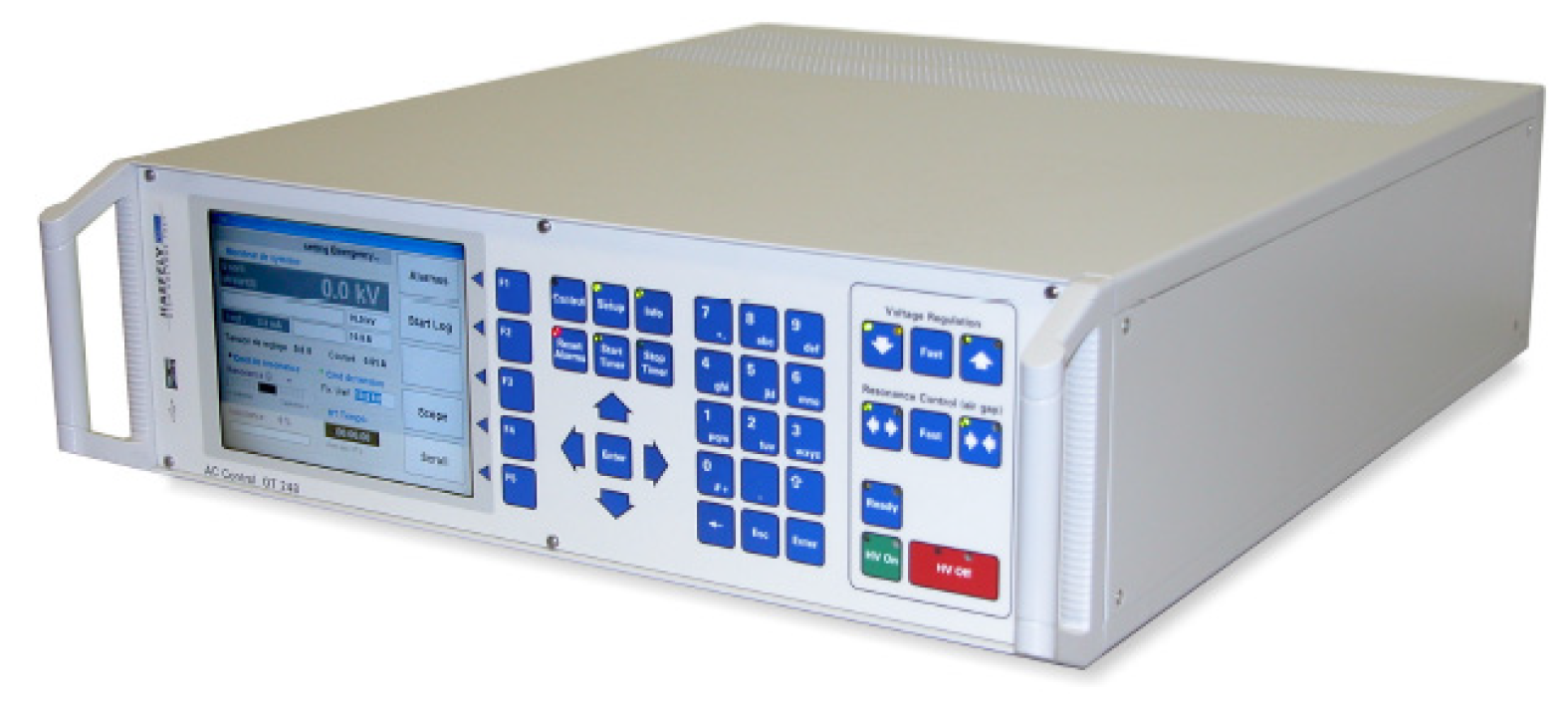


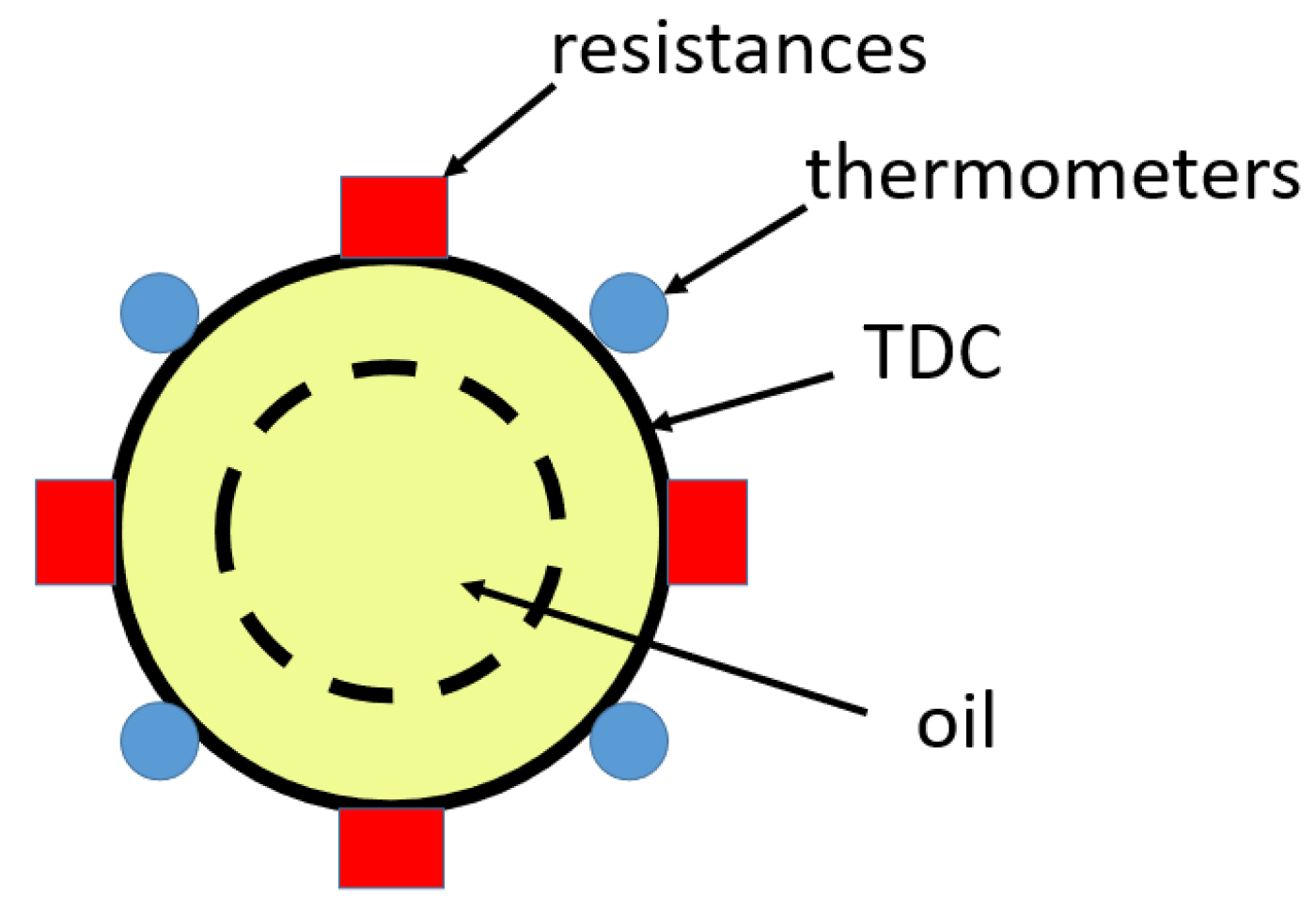

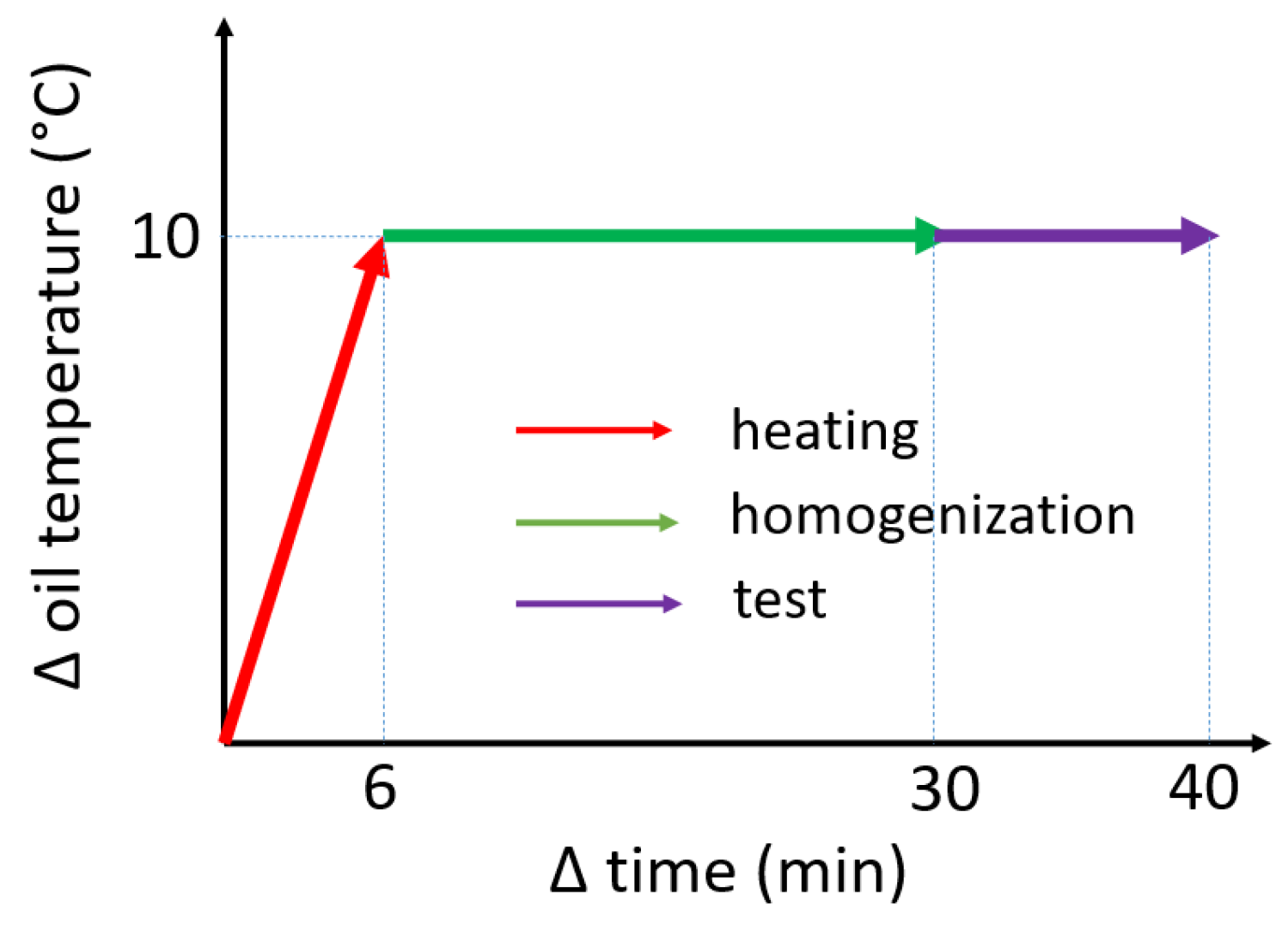


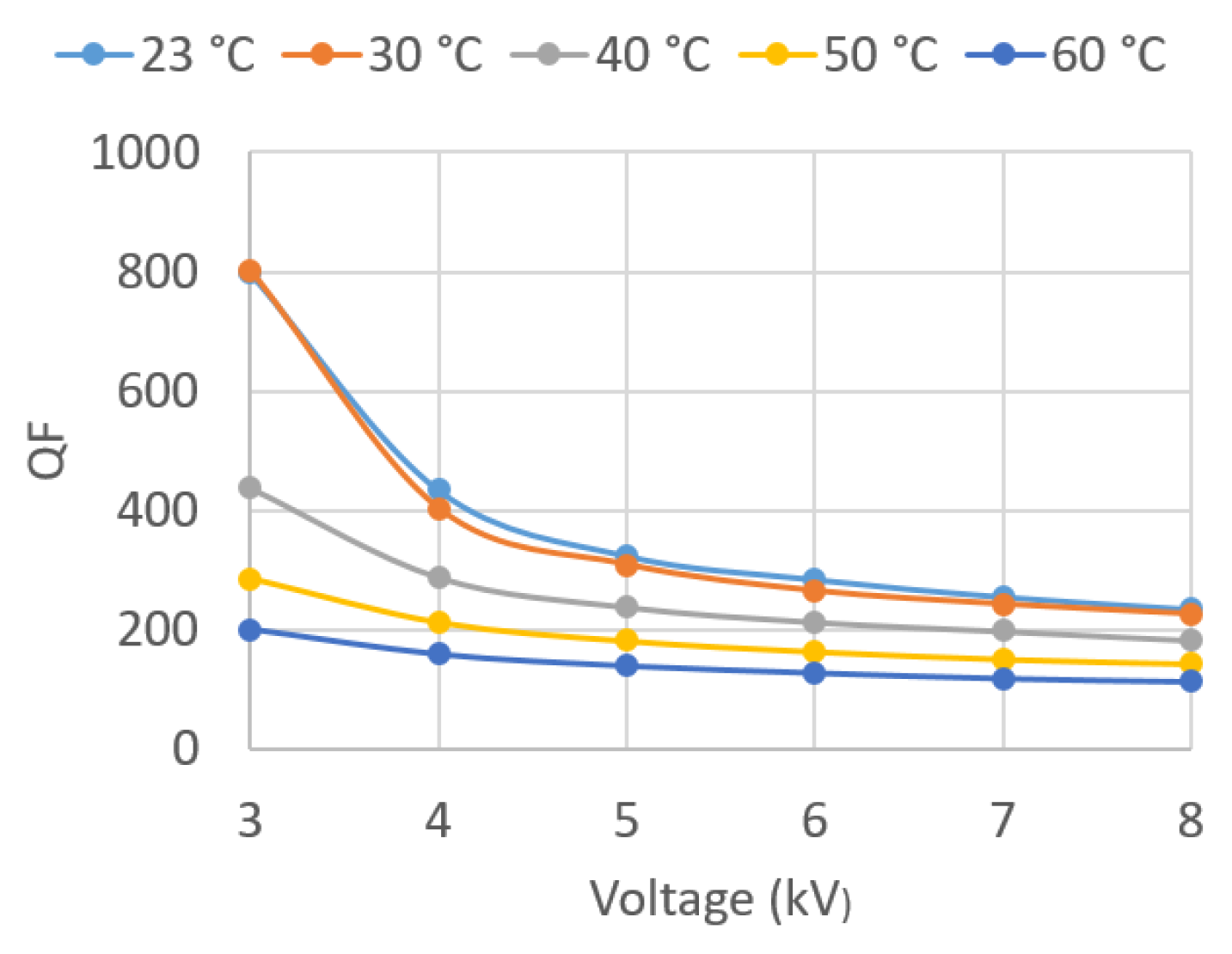
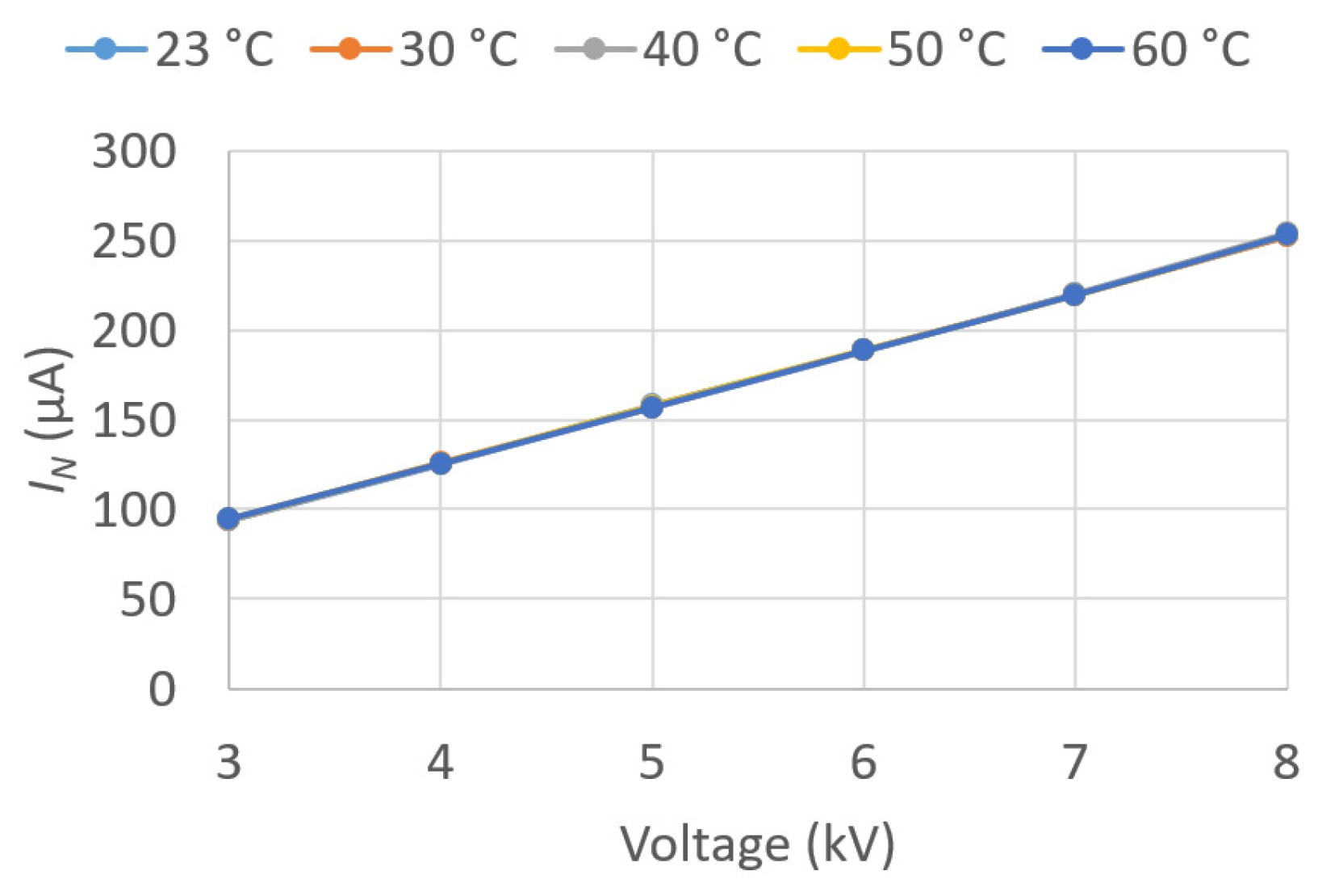

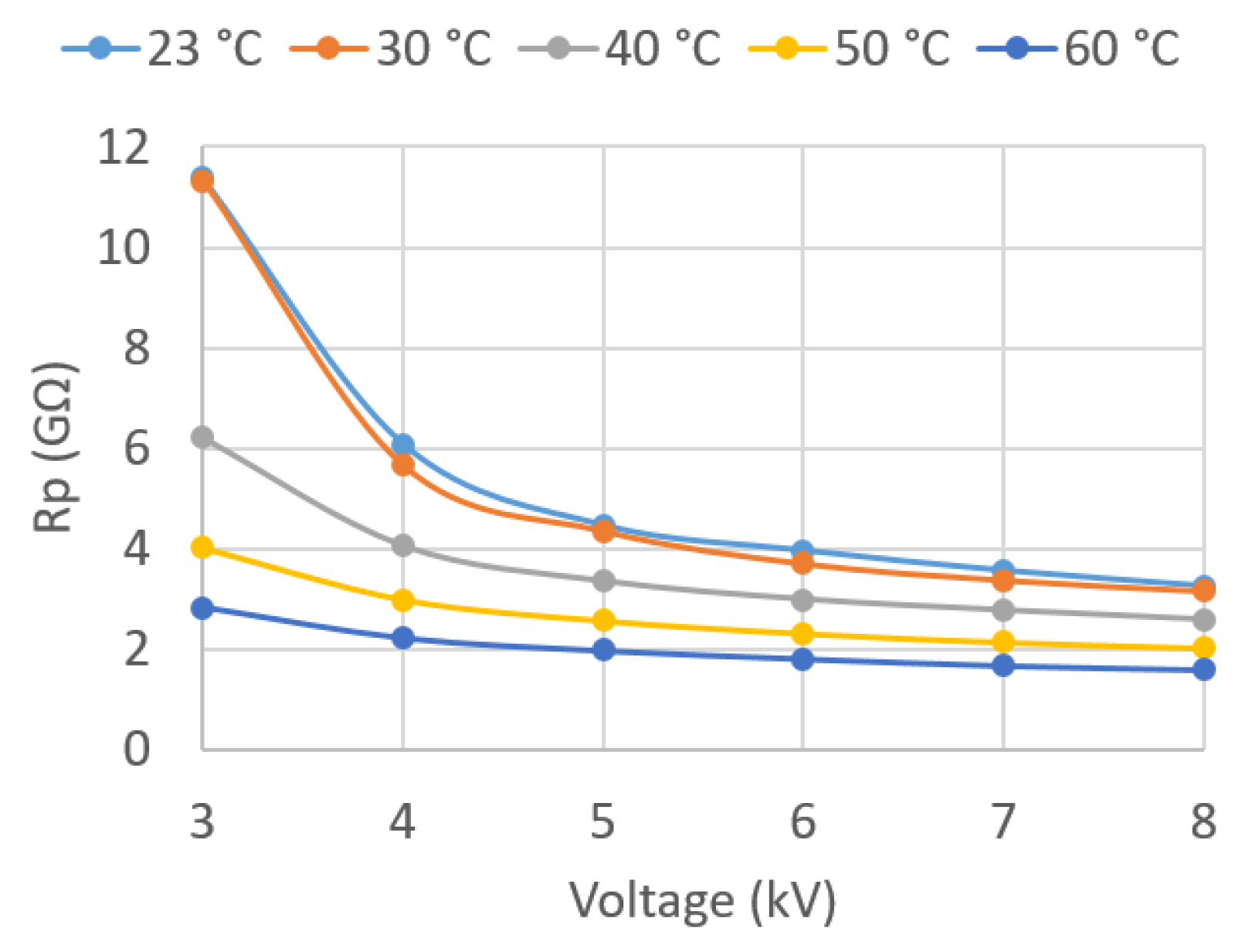
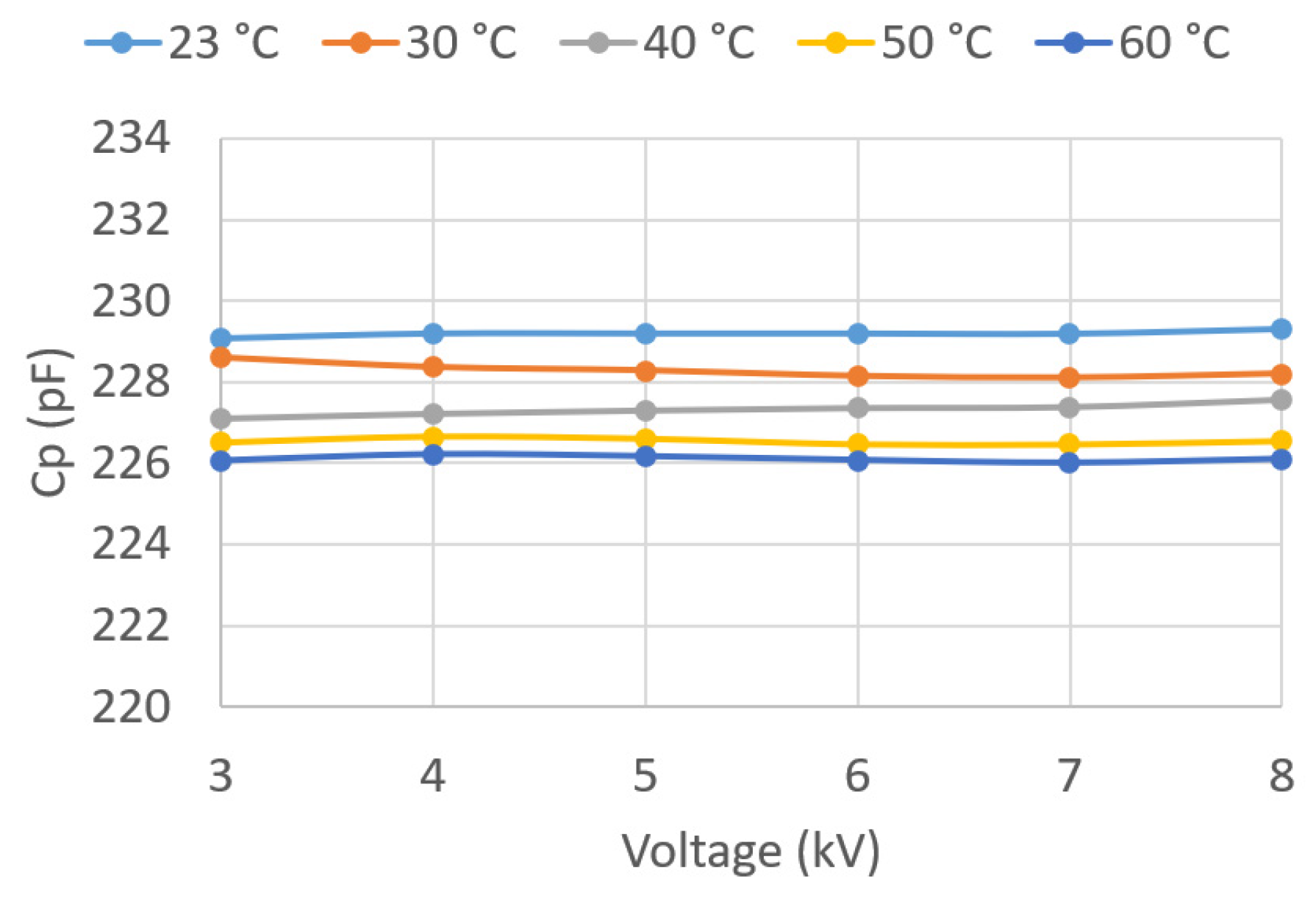

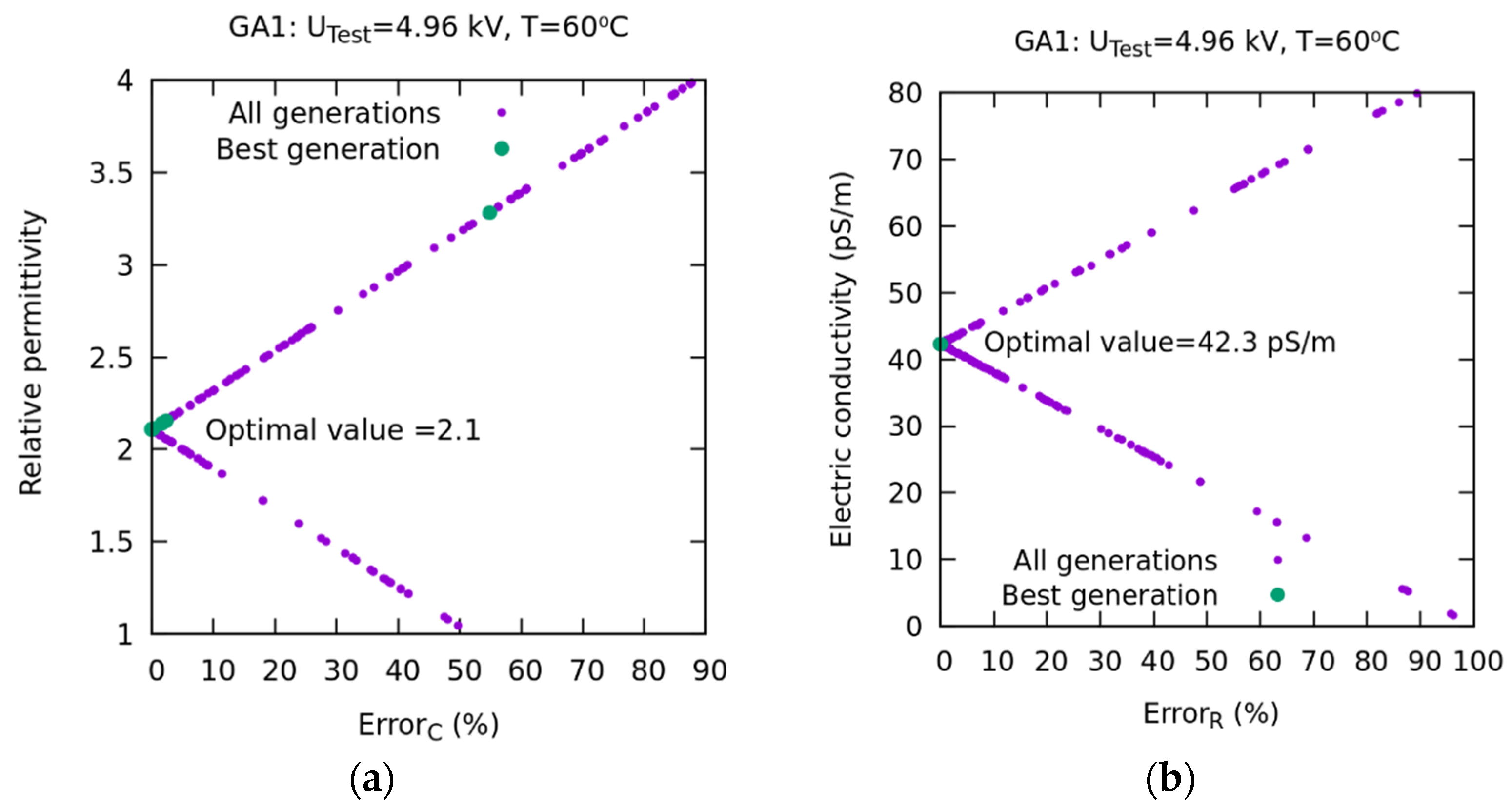


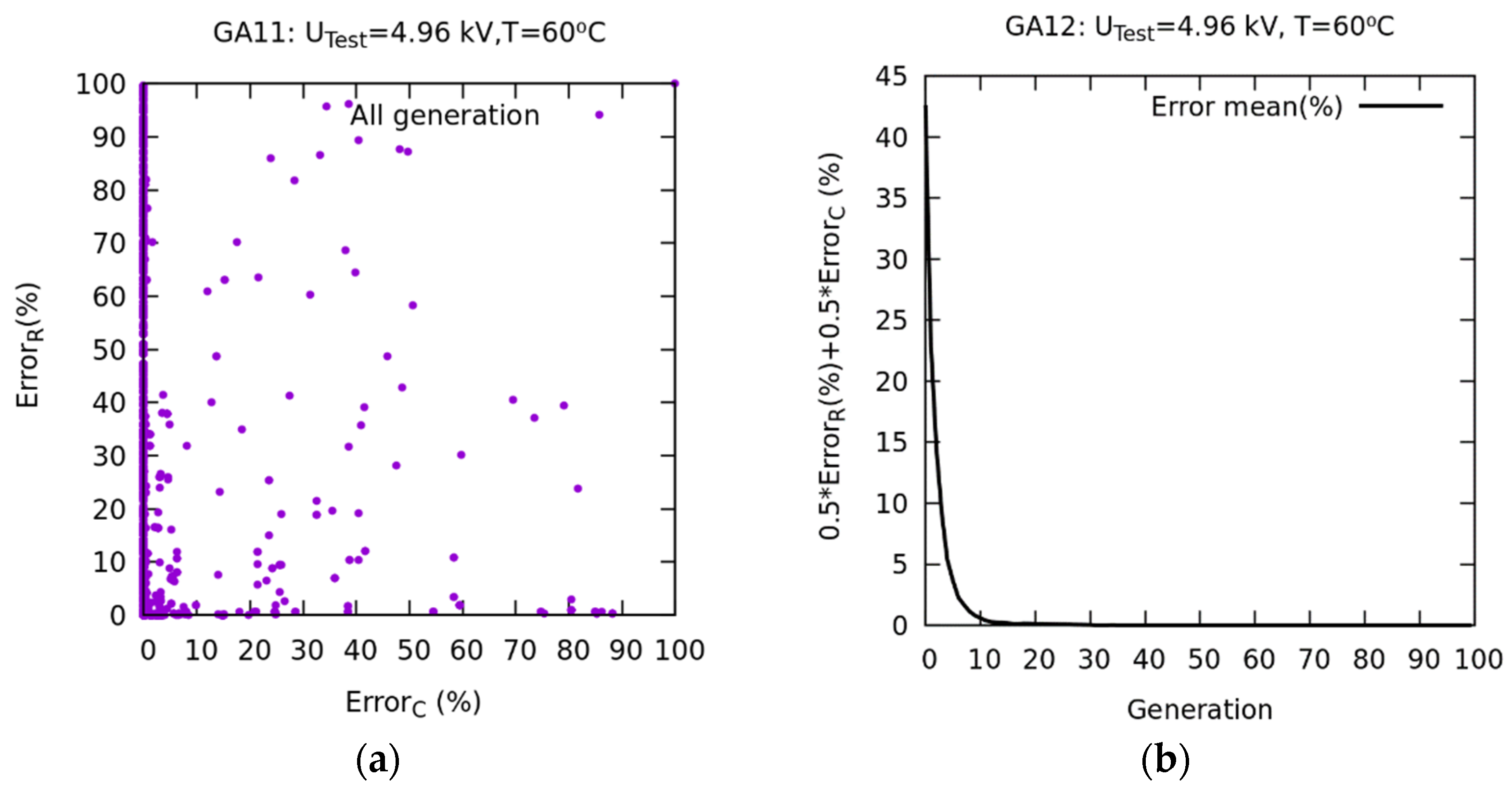
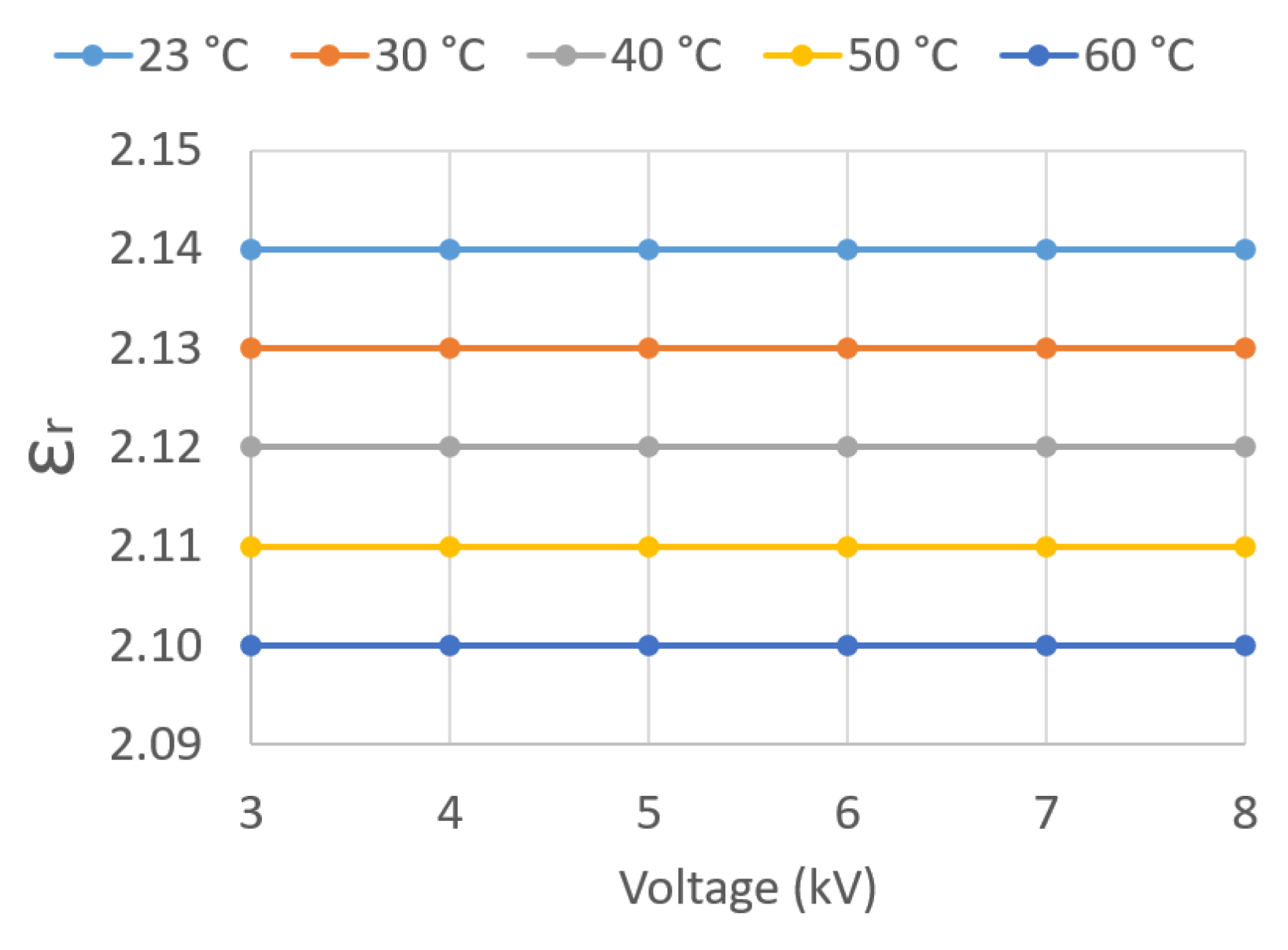




| Property | Value |
|---|---|
| Empty capacitance | About 109 pF |
| Radial electrode spacing | 6.7 mm |
| Quantity of liquid | About 1050 cm3 |
| Max. test voltage | 10 kV, 50/60 Hz |
| Dimensions | Ø 178 × H 190 mm |
| Experiment Name | Number of Objective Functions and Method | Number of Generations | UTest (kV) | T (°C) | (pS/m) | |
|---|---|---|---|---|---|---|
| GA1 | 2-PF | 20 | 4.96 | 60 | 2.10 | 42.3 |
| GA2 | 2-PF | 20 | 8.05 | 60 | 2.10 | 52.3 |
| GA3 | 2-PF | 20 | 3.00 | 50 | 2.11 | 20.7 |
| GA4 | 2-PF | 20 | 6.01 | 50 | 2.11 | 36.3 |
| GA5 | 2-PF | 20 | 3.96 | 40 | 2.12 | 20.6 |
| GA6 | 2-PF | 20 | 8.11 | 40 | 2.12 | 32.4 |
| GA7 | 2-PF | 20 | 2.96 | 30 | 2.13 | 7.2 |
| GA8 | 2-PF | 20 | 8.04 | 30 | 2.13 | 26.7 |
| GA9 | 2-PF | 20 | 5.17 | 23 | 2.14 | 18.6 |
| GA10 | 2-PF | 20 | 6.02 | 23 | 2.14 | 21.2 |
| GA11 | 2-PF | 100 | 4.96 | 60 | 2.10 | 42.3 |
| GA12 | 1-WS | 100 | 4.96 | 60 | 2.10 | 42.3 |
| Parameter | Value |
|---|---|
| Population size | 40 |
| Number of real variables | 2 |
| Lower limit of real variable 1 [σ] | 0.152 pS/m |
| Upper limit of real variable 1 [σ] | 80.0 pS/m |
| Lower limit of real variable 2 [εr] | 1.0 |
| Upper limit of real variable 2 [εr] | 4.0 |
| Probability of crossover of real variable | 0.9 |
| Probability of mutation of real variable | 0.5 |
| Seed for random number generator | 0.5 |
| Number of crossovers of real variable | 1796 for 100 generations |
| Number of mutations of real variable | 3923 for 100 generations |
| Execution time | 56 min 47 s for 100 generations |
| 3 | 4 | 5 | 6 | 7 | 8 | |
|---|---|---|---|---|---|---|
| Eac (eV) | 3.485 | 2.655 | 2.274 | 2.104 | 2.038 | 1.948 |
| A (µS/m) | 5.440 | 0.391 | 0.117 | 0.008 | 0.006 | 0.004 |
Disclaimer/Publisher’s Note: The statements, opinions and data contained in all publications are solely those of the individual author(s) and contributor(s) and not of MDPI and/or the editor(s). MDPI and/or the editor(s) disclaim responsibility for any injury to people or property resulting from any ideas, methods, instructions or products referred to in the content. |
© 2023 by the authors. Licensee MDPI, Basel, Switzerland. This article is an open access article distributed under the terms and conditions of the Creative Commons Attribution (CC BY) license (https://creativecommons.org/licenses/by/4.0/).
Share and Cite
Monzón-Verona, J.M.; González-Domínguez, P.; García-Alonso, S. Effective Electrical Properties and Fault Diagnosis of Insulating Oil Using the 2D Cell Method and NSGA-II Genetic Algorithm. Sensors 2023, 23, 1685. https://doi.org/10.3390/s23031685
Monzón-Verona JM, González-Domínguez P, García-Alonso S. Effective Electrical Properties and Fault Diagnosis of Insulating Oil Using the 2D Cell Method and NSGA-II Genetic Algorithm. Sensors. 2023; 23(3):1685. https://doi.org/10.3390/s23031685
Chicago/Turabian StyleMonzón-Verona, José Miguel, Pablo González-Domínguez, and Santiago García-Alonso. 2023. "Effective Electrical Properties and Fault Diagnosis of Insulating Oil Using the 2D Cell Method and NSGA-II Genetic Algorithm" Sensors 23, no. 3: 1685. https://doi.org/10.3390/s23031685
APA StyleMonzón-Verona, J. M., González-Domínguez, P., & García-Alonso, S. (2023). Effective Electrical Properties and Fault Diagnosis of Insulating Oil Using the 2D Cell Method and NSGA-II Genetic Algorithm. Sensors, 23(3), 1685. https://doi.org/10.3390/s23031685






